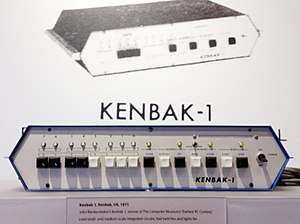Kenbak-1
The Kenbak-1 is considered by the Computer History Museum and the American Computer Museum[1] to be the world's first "personal computer",[2] invented by John V. Blankenbaker (1930-) of Kenbak Corporation in 1970, and first sold in early 1971.[3] Only 50 machines were ever built using Bud Industries enclosures as its housing per the Oral History of John Blankenbaker. The system first sold for US$750.[4] Today only 14 machines are believed to exist worldwide,[5] in the hands of various collectors. Production of the Kenbak-1 stopped in 1973[6] as Kenbak failed, and was taken over by CTI Education Products, Inc. CTI rebranded the inventory and renamed it the H5050, though sales remained elusive.[7]
 A Kenbak-1 at the Computer History Museum | |
| Developer | John Blankenbaker |
|---|---|
| Manufacturer | Kenbak Corporation |
| Type | personal computer |
| Release date | 1971 |
| Introductory price | US$750 (equivalent to $4,735 in 2019) |
| Discontinued | 1973 |
| Units sold | 40 |
| Units shipped | 40 |
| Memory | 256 bytes of memory |
Since the Kenbak-1 was invented before the first microprocessor, the machine didn't have a one-chip CPU but instead was based purely on small-scale integration TTL chips.[8] The 8-bit machine offered 256 bytes of memory,[9] implemented on Intel's type 1404 silicon gate MOS shift registers.[10] The instruction cycle time was 1 microsecond (equivalent to an instruction clock speed of 1 MHz), but actual execution speed averaged below 1000 instructions per second due to architectural constraints such as slow access to serial memory.[8]
The machine was programmed in pure machine code using an array of buttons and switches. Output consisted of a row of lights.
See also
- Datapoint 2200, a contemporary machine with alphanumeric screen and keyboard, suitable to run non-trivial application programs.
- Mark-8 The Mark-8 was designed by graduate student Jonathan A. Titus and announced as a 'loose kit' in the July 1974 issue of Radio-Electronics magazine.
- Altair 8800, a very popular 1975 microcomputer that provided the inspiration for starting Microsoft.
References
- "The George R. Stibitz Computer Pioneer Award". Archived from the original on September 13, 2008. Retrieved August 5, 2008.
- "Timeline of Computer History". Computer History Museum. Retrieved July 22, 2008.
- BBC News, November 6, 2015
- "Kenbak-1 The Training Computer". Computerworld. November 17, 1971. p. 43. Retrieved May 25, 2014.
- "Kenbak-1". Computer Museum of Nova Scotia. Retrieved 19 November 2015.
- p. 52, "The First Personal Computer", Popular Mechanics, January 2000.
- Robert R Nielsen, Snr (2005). "Inside the Kenbak-1". Retrieved 8 November 2015.
- Erik Klein. "Kenbak Computer Company Kenbak-1". Old-computers.com. Retrieved May 25, 2014.
- Bill Wilson (6 November 2015). "The man who made 'the world's first personal computer'". BBC News.
- "Technical".
External links
- KENBAK-1 Computer Article
- KENBAK-1 Computer – Official Kenbak-1 website at www.kenbak-1.net
- KENBAK-1 Series 2 – Official Kenbak-1 reproduction kit at www.kenbakkit.com
- Kenbak-1 Emulator – Online Kenbak-1 Emulator
- Kenbak-1 Emulator – Kenbak-1 Emulator download
- The Kenbak 1 - The first Personal Computer – At the Computer Museum of Nova Scotia
- Kenbak 1 – Images and information at www.vintage-computer.com
- Kenbak documentation at bitsavers.org
- KENBAK-uino Hardware-based Kenbak-1 Emulator
- Recreating the First PC article about KENBAK-uino at hackaday.com
- KENBAK-1 Emulator/Trainer, RetroWiki.es (Invalid, 2015-02-10)
- The Kenbak-1 Prototype, Official Kenbak-1 prototype website at www.thefirstpc.com